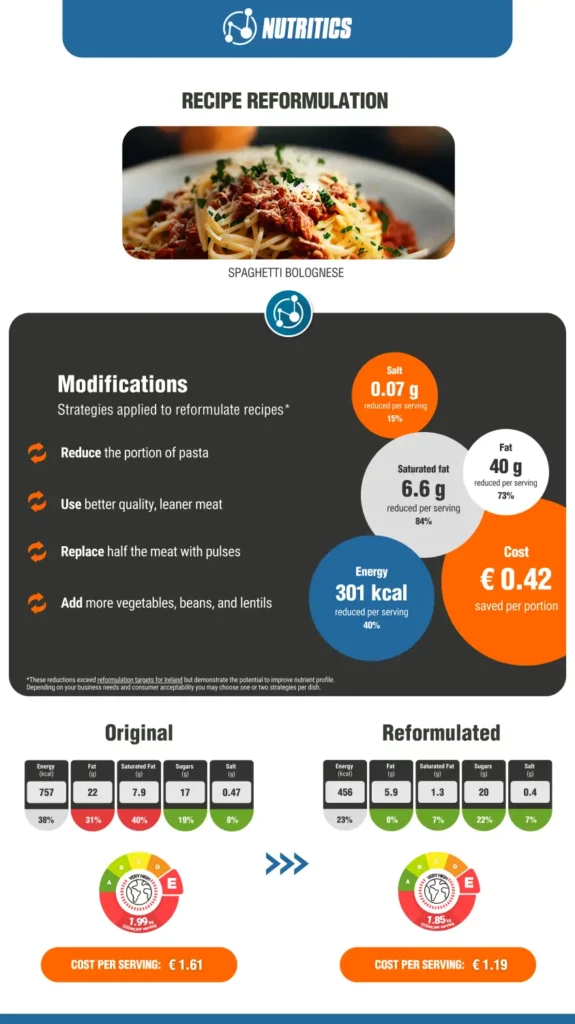Today we reformulate another popular dish found in Italian restaurants across the UK – Spaghetti Bolognese…
Could a few tweaks improve the nutrient profile, cost and environmental impact of the dish, whilst still delivering on taste?
A classic Spaghetti Bolognese was used as a starting point. The recipe was changed to improve nutrient profile, cost and environmental impact, with the final dish aligning with industry portion size standards and consistent with published test recipes.
Let’s get in the kitchen…
Below is a summary of the changes that were made:
- Extra-large portions of pasta (260g) were reduced to a medium portion (130g).
- 560g of Beef Mince was replaced with lean beef mince and the quantity was reduced to 200g.
- Green and Brown Lentils were added to replace the mince.
- The amount of vegetables included in the recipe was increased.
- The quantity of carrots increased from 67g to 240g.
- Celery (110g) was added to the reformulated recipe.
What difference does our reformulated recipe make?
Greenhouse gas emissions:
The original Spaghetti Bolognese had a CO2eq (carbon dioxide equivalent) per serving score of 1.99kg – an E on the Foodprint scale.
However, by cutting down on the beef and replacing it with lentils, the new recipe had a score of 1.85kg CO2eq per serving.
Whilst dishes containing meat will often give a higher score than dishes made with plant-based ingredients, this shows that reducing certain ingredients can still make a difference, without impacting on the taste for customers.
Water usage:
A reduction in water usage is where the reformulations on this recipe really demonstrate their environmental benefits.
The original recipe used a huge 3,341L of water per serving, because of the amount of water required in the production of beef. The new dish uses nearly half of this, using 1,751L per serving. Whilst this is still high, it is nonetheless a sizable saving – the equivalent of running the shower for 106 minutes.
Nutritional Profile:
Next, we look at the improvements we can make to the nutritional profile of this Italian classic.
The original Spaghetti Bolognese contained 757 kcal, 22g of fat and 7.9g of Saturated fat.
However, the new recipe contains 456 kcal, 5.9g of fat and 1.3g of saturated fat, with the reduction in beef a major contributing factor to this.
The calorie saving is equivalent to three scoops of vanilla ice cream!
Cost:
Finally, let’s discuss the potential cost savings to be made, an important issue for many businesses at this time.
While the original Spaghetti Bolognese had a cost per serving of €1.61, the reformulated recipe brings this down to €1.19.
Based on 50 covers per day, that’s the equivalent to a monthly saving of €630.

Final thoughts…
This is just one example of how a few tweaks to your recipe can improve both their environmental impact and the nutritional profile, whilst saving you money in the process.
The Foodprint software from Nutritics was created to put hospitality and foodservice businesses on a path to more responsible sourcing. With more than four million ingredients in its database, it can provide a credible, evidence-based environmental score for your recipes, covering carbon footprint and water usage so that you can make changes behind the scenes.
If you’re looking for sustainability support for your restaurant, the team at Knowledge Labs from Nutritics are here to help. Get in contact today!
